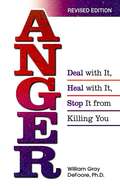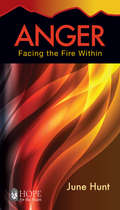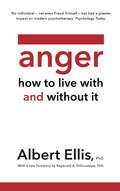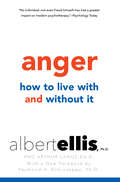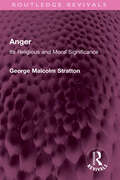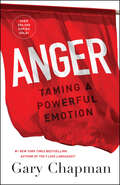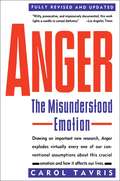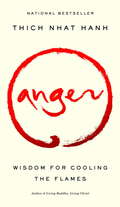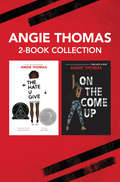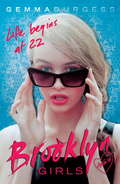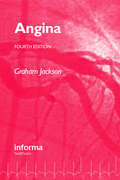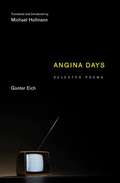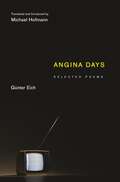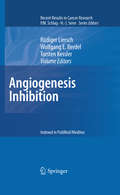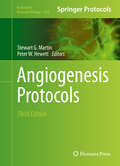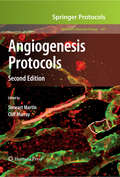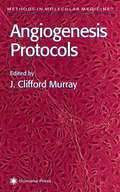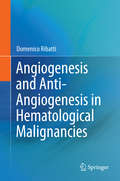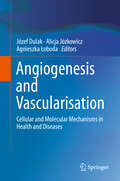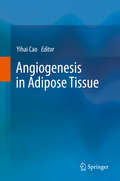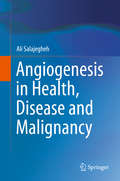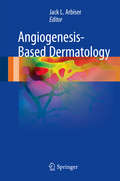- Table View
- List View
Anger: Deal With It, Heal With It, Stop It From Killing You
by William Gray DeFooreWilliam DeFoore provides practical solutions to one of society's most pressing concerns-anger and rage. His practical ten-step approach offers a way to reach a new level of psychological and physical health by learning to deal with anger in healthy ways. Through gripping stories, research and narrative, DeFoore explores the many faces of anger, including passive anger, anger during the grief process, anger among males, and anger that can actually help us connect with our spirituality and life purpose. This edition has added new chapters that cover anger in women, anger in children, in school, in the workplace, and domestic violence.
Anger: Facing the Fire Within (Hope for the Heart)
by June HuntAnger MinibookBiblical Counseling on Anger Management from Hope for the HeartHas anger or rage ever clouded your judgment to the point that you acted rashly and then regretted it later? What do you do when you are inflamed with angry thoughts and feelings? Ultimately, you have the choice to act wisely or to react foolishly. You can learn to keep your anger under control with this practical advice from June Hunt.Anger will shed light on the warning signs, or characteristics, of both acceptable and unacceptable anger. Includes:•"Cues to Find Hidden Anger" checklist, making it easy to diagnose different ways in which your body is reacts to anger •"Act or React" checklistJune Hunt starts this minibook with a definitions section with simple explanations of each word associated with anger. Learn the magnitude, misuse, and misconceptions of anger. Also included in the definitions section are biblical examples of anger. For example, an example of acceptable anger is when injustice ignited righteous anger" in Jesus. Conversely, we find "unacceptable anger" in story of Saul and David, when King Saul's jealous anger over David's military victories burned like a fire, destroying many relationships including his relationship with God.The last section titled ‚"Steps to Solution‚" gives you the power to be freed from anger with:•The 4 sources of anger•4 Truths that will change your life•How to measure the amount of your anger•3 steps to resolving anger•Releasing your anger prayer•And much more.Look for all 25 titles in the Hope For The Heart Biblical Counseling Library. These mini-books are for people who seek freedom from codependency, anger, conflict, verbal and emotional abuse, depression, or other problems.
Anger: How to Live With and Without It
by Albert Ellis PhDAnger. It's one of our most basic, and often most destructive, human emotions. And in today's world, it's a constant, escalating force, from road rage to domestic abuse, from teen violence to acts of terrorism. More than ever we need effective ways to live with it, understand it-and learn to deal with it. This landmark book from world-renowned psychotherapist Dr. Albert Ellis, creator of Rational Emotive Behavior Therapy (REBT), shows you how.Presented in a simple step-by-step program that anyone can master, the proven, time-tested principles of REBT teach you to manage and even eliminate anger, without sacrificing necessary assertiveness. Here you'll discover:*What exactly is anger, and must you feel it?*How you create your own anger*Methods of thinking, feeling, and acting your way out of anger*Why holding on to anger is sometimes fun-and how to let it go*How to use REBT to cope with tragic events that are far beyond our control...and much more, including numerous real-world case studies, plus a comprehensive, critical analysis of the various approaches to this age-old problem. Whether at home or at work, in a personal or political context, this breakthrough approach will enable you to take control of the anger that can stand in the way of success and happiness.
Anger: How to Live with and without It
by Albert Ellis Arthur LangeWith a New Foreword by Raymond A. DiGiuseppe, Ph.D.CLASSIC SELF-HELP FROM A RESPECTED PIONEER OF PSYCHOTHERAPYAnger. It’s one of our most basic, and often most destructive, human emotions. And in today’s world, it’s a constant, escalating force, from road rage to domestic abuse, from teen violence to acts of terrorism. More than ever we need effective ways to live with it, understand it—and learn to deal with it. This landmark book from world-renowned psychotherapist Dr. Albert Ellis, creator of Rational Emotive Behavior Therapy (REBT), shows you how.Presented in a simple step-by-step program that anyone can master, the proven, time-tested principles of REBT teach you to manage and even eliminate anger, without sacrificing necessary assertiveness. Here you’ll discover:*What exactly is anger, and must you feel it?*How you create your own anger*Methods of thinking, feeling, and acting your way out of anger*Why holding on to anger is sometimes fun—and how to let it go*How to use REBT to cope with tragic events that are far beyond our control…and much more, including numerous real-world case studies, plus a comprehensive, critical analysis of the various approaches to this age-old problem. Whether at home or at work, in a personal or political context, this breakthrough approach will enable you to take control of the anger that can stand in the way of success and happiness.
Anger: Its Religious and Moral Significance (Routledge Revivals)
by George Malcolm StrattonFirst published in 1923, Anger presents some considerations of anger where it comes close to conduct and religion. It is hoped that the explanation of conscience, and of the origins of religion, and particularly of monotheism has been carried a firm step farther than hitherto, and that interest will be found in the novel grouping of the great faiths with respect to wrath. The spirit of the great religions is drawn from their sacred writings. This book will be of interest to students of philosophy and religion.
Anger: Taming a Powerful Emotion
by Gary ChapmanHelp for anger management — from NYT bestselling author Gary ChapmanAnger is a cruel master. If you struggle even a little with anger, you know how it feels to get mad too easily. To lash out at someone you love. To hold onto frustration. You might even notice others seem uneasy around you. You know anger is hurting your life, but you don&’t know how to fix it.There is hope. When you understand why you get angry and what to do about it, you can change the course of your life for the better. In Anger: Taming a Powerful Emotion, counselor Gary Chapman shares surprising insights about anger, its effect on relationships, and how to overcome it. His advice and real-life examples will help you: Understand yourself betterOvercome shame, denial, and bitterness Discern good anger from bad angerManage anger and conflict constructively Make positive life changesLet go of your grudges and resentmentHelp others (like your children) deal with anger and moreWhether your anger is quiet or explosive, if it&’s clouding your judgment and hurting your relationships, it needs to go. Learn to handle anger in healthy ways, starting today. Gary Chapman is wise and empathetic, and he'll help you turn over a new leaf.
Anger: Taming a Powerful Emotion
by Gary ChapmanHelp for anger management — from NYT bestselling author Gary ChapmanAnger is a cruel master. If you struggle even a little with anger, you know how it feels to get mad too easily. To lash out at someone you love. To hold onto frustration. You might even notice others seem uneasy around you. You know anger is hurting your life, but you don&’t know how to fix it.There is hope. When you understand why you get angry and what to do about it, you can change the course of your life for the better. In Anger: Taming a Powerful Emotion, counselor Gary Chapman shares surprising insights about anger, its effect on relationships, and how to overcome it. His advice and real-life examples will help you: Understand yourself betterOvercome shame, denial, and bitterness Discern good anger from bad angerManage anger and conflict constructively Make positive life changesLet go of your grudges and resentmentHelp others (like your children) deal with anger and moreWhether your anger is quiet or explosive, if it&’s clouding your judgment and hurting your relationships, it needs to go. Learn to handle anger in healthy ways, starting today. Gary Chapman is wise and empathetic, and he'll help you turn over a new leaf.
Anger: The Conflicted History of an Emotion (Vices and Virtues)
by Barbara H. RosenweinTracing the story of anger from the Buddha to Twitter, Rosenwein provides a much-needed account of our changing and contradictory understandings of this emotion All of us think we know when we are angry, and we are sure we can recognize anger in others as well. But this is only superficially true. We see anger through lenses colored by what we know, experience, and learn. Barbara H. Rosenwein traces our many conflicting ideas about and expressions of anger, taking the story from the Buddha to our own time, from anger&’s complete rejection to its warm reception. Rosenwein explores how anger has been characterized by gender and race, why it has been tied to violence and how that is often a false connection, how it has figured among the seven deadly sins and yet is considered a virtue, and how its interpretation, once largely the preserve of philosophers and theologians, has been gradually handed over to scientists—with very mixed results. Rosenwein shows that the history of anger can help us grapple with it today.
Anger: The Misunderstood Emotion
by Carol TavrisA Simon & Schuster eBook. Simon & Schuster has a great book for every reader.
Anger: Wisdom for Cooling the Flames
by Thich Nhat HanhThe Nobel Peace Prize nominee and internationally bestselling author shares the tools and power for overcoming anger. "Thich Nhat Hanh is a holy man, for he is humble and devout. He is a scholar of immense intellectual capacity. <P><P>His ideas for peace, if applied, would build a monument to ecumenism, to world brotherhood, to humanity". Martin Luther King, Jr. , in nominating Thich Nhat Hanh for the Nobel Peace Prize It was under the bodhi tree in India twenty-five centuries ago that Buddha achieved the insight that three states of mind were the source of all our unhappiness: ignorance, obsessive desire, and anger. All are equally difficult, but in one instant of anger, lives can be ruined, and our spiritual development can be destroyed. Twenty-five hundred years after the Buddha's enlightenment, medical science tells us that the Buddha was right: anger can also ruin our health. It is one of the most powerful emotions and one of the most difficult to change. Thich Nhat Hanh offers a fresh perspective on taking care of our anger as we would take care of a crying baby-picking it up, talking quietly to it, probing for what is making the baby cry. Laced with stories and techniques, Anger offers a wise and loving look at transforming anger into peace and for bringing harmony and healing to all the areas and relationships in our lives that have been affected by anger.
Angie Thomas 2-Book Collection: The Hate U Give and On the Come Up
by Angie ThomasDiscover the critically acclaimed, #1 New York Times bestselling The Hate U Give and the highly anticipated On the Come Up from Angie Thomas in this two-book collection.FIND YOUR VOICE. MAKE SOME NOISE.The Hate U GiveWilliam C. Morris Award Winner ∙ National Book Award Longlist ∙ Michael L. Printz Honor Book ∙ Coretta Scott King Author Honor Book"Absolutely riveting!" —Jason Reynolds"Stunning." —John Green"This story is necessary. This story is important."—Kirkus (starred review)"Heartbreakingly topical."—Publishers Weekly (starred review)Sixteen-year-old Starr Carter moves between two worlds: the poor neighborhood where she lives and the fancy suburban prep school she attends. The uneasy balance between these worlds is shattered when Starr witnesses the fatal shooting of her childhood best friend Khalil at the hands of a police officer. On the Come Up Sixteen-year-old Bri wants to be one of the greatest rappers of all time. Or at least win her first battle. As the daughter of an underground hip hop legend who died right before he hit big, Bri’s got massive shoes to fill. But it’s hard to get your come up when you’re labeled a hoodlum at school, and your fridge at home is empty after your mom loses her job. So Bri pours her anger and frustration into her first song, which goes viral…for all the wrong reasons.
Angie: Book 2 (Brooklyn Girls #2)
by Gemma BurgessBroke. Broken-hearted. Bored. (Not necessarily in that order.) WELCOME TO NEW YORK CITY. Angie James is lost. A regular poster girl for Generation Screwed, being 22 isn't what she expected. What happens when having fun isn't, you know, fun? In the Brooklyn townhouse she shares with her best friends, Angie wants to figure out what to do with her life. But wild parties, bad dates, dead-end jobs, demanding fashionistas and even true love just keep getting in the way... Who knew adulthood would be so damn grown-up?
Angina
by Graham JacksonThis fourth edition of Angina has been extensively revised and expanded with regard to the increasing importance of managing hyperlipidemia, diagnosing and treating coronary artery disease in women and the elderly, and managing chest pain in the presence of normal coronary arteries. Additionally, the roles of medicine, percutaneous coronary interve
Angina Days
by Günter EichThis is the most comprehensive English translation of the work of Günter Eich, one of the greatest postwar German poets. The author of the POW poem "Inventory," among one of the most famous lyrics in the German language, Eich was rivaled only by Paul Celan as the leading poet in the generation after Gottfried Benn and Bertolt Brecht. Expertly translated and introduced by Michael Hofmann, this collection gathers eighty poems, many drawn from Eich's later work and most of them translated here for the first time. The volume also includes the original German texts on facing pages. As an early member of "Gruppe 47" (from which Günter Grass and Heinrich Böll later shot to prominence), Eich (1907-72) was at the vanguard of an effort to restore German as a language for poetry after the vitriol, propaganda, and lies of the Third Reich. Short and clear, these are timeless poems in which the ominousness of fairy tales meets the delicacy and suggestiveness of Far Eastern poetry. In his late poems, he writes frequently, movingly, and often wryly of infirmity and illness. "To my mind," Hofmann writes, "there's something in Eich of Paul Klee's pictures: both are homemade, modest in scale, immediately delightful, inventive, cogent." Unjustly neglected in English, Eich finds his ideal translator here.
Angina Days: Selected Poems (Facing Pages)
by Günter EichA bilingual edition of one of the most important German poets of the twentieth centuryThis is the most comprehensive English translation of the work of Günter Eich, one of the greatest postwar German poets. The author of the POW poem "Inventory," among one of the most famous lyrics in the German language, Eich was rivaled only by Paul Celan as the leading poet in the generation after Gottfried Benn and Bertolt Brecht. Expertly translated and introduced by Michael Hofmann, this collection gathers eighty poems, many drawn from Eich's later work and most of them translated here for the first time. The volume also includes the original German texts on facing pages.As an early member of "Gruppe 47" (from which Günter Grass and Heinrich Böll later shot to prominence), Eich (1907-72) was at the vanguard of an effort to restore German as a language for poetry after the vitriol, propaganda, and lies of the Third Reich. Short and clear, these are timeless poems in which the ominousness of fairy tales meets the delicacy and suggestiveness of Far Eastern poetry. In his late poems, he writes frequently, movingly, and often wryly of infirmity and illness. "To my mind," Hofmann writes, "there's something in Eich of Paul Klee's pictures: both are homemade, modest in scale, immediately delightful, inventive, cogent."Unjustly neglected in English, Eich finds his ideal translator here.
Angiogenesis Inhibition (Recent Results in Cancer Research #180)
by Torsten Kessler Wolfgang E. Berdel Rüdiger LierschAngiogenesis is attracting increased scientific and clinical interest. The identification of novel mediators and targeting molecules has led to significant progress in our understanding of tumor angiogenesis and tumor vessel targeting. Important advances in cancer treatment have already emerged, and in the future, blood vessel targeting will play a significant role within individualized therapeutic strategies. This volume provides a general overview of the latest developments in angiogenesis inhibition in cancer. All aspects from the bench to the bedside are considered, with detailed attention both to basic research and to its translation into clinical practice. Individual chapters are devoted to the roles of angiopoietins, HIF-1a, chemokines, PDGF and VEGF, and vascular integrins. The latest results of clinical trials are presented, and various advanced targeting strategies are discussed. This book will be invaluable to all who wish to learn of the most recent advances in this exciting field.
Angiogenesis Modulations in Health and Disease: Practical Applications of Pro- and Anti-angiogenesis Targets
by Shaker A. Mousa Paul J. DavisThis book is a major update of novel targets in angiogenesis modulation, including pro- and anti-angiogenesis. There is in-depth coverage of preclinical and clinical methods and models, investigational status, and clinical applications. The impact of nanotechnology in advancing the applications of pro-and anti-angiogenesis strategies is also highlighted, along with stem cell and biotechnologies in research and development of angiogenesis modulating targets.
Angiogenesis Protocols (Methods in Molecular Biology #1430)
by Stewart G. Martin Peter W. HewettInaddition to updating important core techniques this third edition presents newchapters on assessing leukocyte involvement in angiogenesis, lymphatic cell andpericyte isolation techniques, spheroid and arterial ring based in vitroassays, and on pericyte involvement in angiogenesis. Angiogenesis Protocols,Third Edition also guides readers through new protocols on chorioallantoicmembrane models, corneal pocket assays to assess angio- and lymphangiogenesis,models of muscle angiogenesis, and use of zebrafish embryos to study vascularangiogenesis and senescence. Written in the highly successful Methods inMolecular Biology series format, chapters include introductions to theirrespective topics, lists of the necessary materials and reagents, step-by-step,readily reproducible laboratory protocols, and tips on troubleshooting andavoiding known pitfalls. Authoritativeand practical, Angiogenesis Protocols, Third Edition provides not only apractical handbook for key techniques, but also an informative and enjoyableread for all those interested, no matter how directly, in angiogenesis.
Angiogenesis Protocols (Methods in Molecular Biology #467)
by Cliff Murray Stewart MartinAs experimentation and clinical trials with first generation anti-angiogenic agents have yielded results and our understanding of the biology and physiology of blood and lymphatic vessels has increased, a new angiogenesis volume swiftly became a necessity. Angiogenesis Protocols, Second Edition remains true to its original vision of providing a single source for angiogenesis researchers, irrespective of levels of resource and expertise, by collecting a range of methods for cell isolation and assessing angiogenesis in vivo or in vitro. This information, however, is expanded to include chapters on circulating endothelial progenitor cells, angiogenic signalling pathways, imaging of angiogenesis, and measurement of tissue blood flow. Written in the Methods in Molecular BiologyTM series format, the chapters provide step-by-step laboratory protocols, lists of necessary materials and reagents, and a Notes section, which details tips on troubleshooting and avoiding known pitfalls. Extensive and cutting-edge, Angiogenesis Protocols, Second Edition is not only a practical handbook for key techniques, but also an informative and enjoyable read for all those interested, no matter how directly, in angiogenesis.
Angiogenesis Protocols (Methods in Molecular Medicine #46)
by J. Clifford MurrayA comprehensive collection of key techniques for assessing the formation of new blood vessels in both whole tissues and cell culture. These readily reproducible methods range from low-cost in vitro assays to cutting-edge in vivo models, such as the dorsal window chamber, which demands high levels of surgical skill as well as relatively expensive, custom-made equipment. Timely and highly practical, Angiogenesis Protocols is a gold-standard resource for today's angiogenesis investigator, providing easy access to a wide variety of proven assays suitable for laboratories with greatly differing technical expertise, materials, and financial resources.
Angiogenesis and Anti-Angiogenesis in Hematological Malignancies
by Domenico RibattiIt has been generally accepted that angiogenesis is involved in the pathogenesis of hematological malignancies, like acute and chronic leukemia, lymphoma, myelodysplastic syndromes, myeloproliferative neoplasms and multiple myeloma. The extent of angiogenesis in the bone marrow has been correlated with disease burden, prognosis and treatment outcome. Reciprocal positive and negative interactions between tumor cells and bone marrow stromal cells, namely hematopoietic stem cells, fibroblasts, osteoblasts/osteoclasts, endothelial cells, endothelial progenitor cells, T cells, macrophages and mast cells, mediated by an array of cytokines, receptors and adhesion molecules, modulate the angiogenic response in hematological tumors. More recently, it has been emphasized the pro-angiogenic role of the so called "vascular niche", indicating a site rich in blood vessels where endothelial cells and mural cells such as pericytes and smooth muscle cells create a microenvironment that affects the behavior of several stem and progenitor cells, in hematological malignancies.
Angiogenesis and Vascularisation: Cellular and Molecular Mechanisms in Health and Diseases
by Józef Dulak Alicja Józkowicz Agnieszka ŁobodaThe book presents the overview of the current knowledge in some fields of vascular biology, addressing cellular and molecular aspects of blood-vessel formation and their role in health and disease. The major factors involved in the formation of blood vessels are presented by scientists actively involved in this area of research. Special emphasis is put on the presentation of various molecular mechanisms not addressed in similar works to date. The book is divided into three parts. The first part describes the cells and mediators in angiogenesis. The significance of various populations of potential endothelial progenitors is particularly highlighted. The chapters of the second part focus on molecular mechanisms, with special emphasis on the role of hypoxia, gasotransmitters and reactive oxygen species as well as microRNAs in regulation of angiogenic processes. In the third part, the pathological aspects of disturbed - aggravated or impaired - vascularization are discussed and new modalities for potential therapies are presented. The book is intended for scientists and PhD students in the fields of vascular biology and cancer research. It may be of interest for medical professionals in the fields of cardiovascular disease, diabetes, oncology and rheumatoid arthritis.
Angiogenesis in Adipose Tissue
by Yihai CaoAngiogenesis has recently played a critical role in regulation of adipose tissue expansion and regression. Like most other tissues in the body, adipose expansion and regression is accompanied by alteration of blood vessel density and structures. The vascular alteration plays an active role in regulation of adipose tissue size and functions. Targeting blood vessels in the adipose tissue have demonstrated to be a novel approach for possibly treatment of cancer, obesity and other metabolic diseases. This book provides the most updated information on this type research and discusses future opportunities for therapy..
Angiogenesis in Health, Disease and Malignancy
by Ali SalajeghehThis book is about "Angiogenesis". A process in which new vasculature is formed from pre-existing capillaries. Angiogenesis process is associated with the proliferation and growth of both physiologically normal and neoplastic tissues, through the formation of vascular supply, essential for delivering growth requirements such as oxygen and nutrients. The book describes more than 100 genes and their key regulatory functions in the context of normal healthy condition, disease and malignancy, cancer proliferation and progression. New insights into the role of angiogenesis and the therapeutic inhibition of its regulators are investigated, due to the great potential for exploitation in the development of a novel treatment for cancer. New scientists, junior researchers and biomedical science students will find this book an invaluable introductory reference to their insight about angiogenesis and angiogenic role of more than 100 angiogenes and their role in healthy, disease and malignant conditions.
Angiogenesis-Based Dermatology
by Jack L. ArbiserThis book provides a complete overview of all aspects of angiogenesis in dermatology. This is a guide to the principles of angiogenesis that will allow all involved in dermatology from the medical student and nurse practitioner to the experienced dermatologist to apply these principles for the treatment of patients. <P><P> Angiogenesis is a principle that can be used to guide treatment of diseases of any organ system. Dermatology may be the first specialty to be guided by the principle of angiogenesis because the lesions are visible and response can be easily monitored. Dermatologists already inhibit angiogenesis as part of their treatment of multiple common dermatologic disorders, including acne, warts, and nonmelanoma skin cancer.
